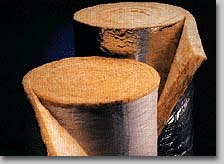|
Pipe Insulation | Duct Insulation | Boiler Tank Insulation
Description
 CertainTeed Standard Duct wrap is a blanket-type insulation composed
of glass fibers bonded together with a thermosetting resin and faced
with either an FSK or vinyl film vapor retarder. FSK is a glass scrim
reinforced laminate of aluminum foil and kraft paper bonded together
with a fire retardant adhesive.
Vinyl film is available in two colors: white or gray. Standard Duct
Wrap is used to insulate rectangular and round heating, ventilating
and air conditioning ductwork that supplies conditioned air temperatures
from 35 degrees F to 250 degrees F in commercial, industrial and residential
buildings. besides conserving valuable energy, the integral vapor retarder
facing, with sufficient thickness of insulation, prevents condensation
on the metal duct surface during cooling operation. CertainTeed Standard Duct wrap is a blanket-type insulation composed
of glass fibers bonded together with a thermosetting resin and faced
with either an FSK or vinyl film vapor retarder. FSK is a glass scrim
reinforced laminate of aluminum foil and kraft paper bonded together
with a fire retardant adhesive.
Vinyl film is available in two colors: white or gray. Standard Duct
Wrap is used to insulate rectangular and round heating, ventilating
and air conditioning ductwork that supplies conditioned air temperatures
from 35 degrees F to 250 degrees F in commercial, industrial and residential
buildings. besides conserving valuable energy, the integral vapor retarder
facing, with sufficient thickness of insulation, prevents condensation
on the metal duct surface during cooling operation.
Sizes, Thicknesses,
Densities
Standard Duct Wrap insulation is available in 48" wide rolls in 1.5",
2" and 3" thicknesses in 0.75 lbs./cu ft. density A selection of vapor
retarder/surface finish facings are available factory applied, complete
with a 2" overlapping facing tab on one edge to provide for a continuous
vapor seal Roll lengths are 100' for 1.5" thickness, 75' for 2" thickness
and 50' for 3" thickness.
Benefits
Lower operating costs
Efficient insulation reduces heat loss or gain. Air is delivered to
outlets at design temperatures.
Greater comfort
Insulation protects conditioned air for better delivery to conditioned
spaces.
Condensation Control
No water stained ceilings due to condensation on cold duct surfaces
if insulation and vapor retarder are installed correctly and with sufficient
insulation thickness.
Low fire hazard classification
Meets or exceeds the fire safety requirements of building codes and
government guide specifications.
Neat, finished appearance
Cuts cleanly with neat square corners. Factory-applied vapor retarder
facings provide a metallic or crips white surface appearance.
Performance
Characteristics
Fire Hazard Classifications: (UL 723, ASTME E 84, NFPA 255)
Flame spread not exceeding 25 and Smoke Developed not exceeding 50.
Performance Characteristics
Thermal Performance(ASTM C 518-76)
Following are R values at 75 degrees F mean temperature.
Density
(lbs./cu. ft) |
Thickness |
R Value |
Type 75
0.75 |
1.5"
2"
3" |
5.2
6.9
10.3 |
Type 100
1.0 |
1.5"
2" |
5.7
7.5 |
Type 150
1.5 |
1.5"
2" |
6.2
8.3 |
The thermal performance
of an insulated sheet metal duct system depends on three design and/or
installation factors:
- Amount of air
leakage in the system transverse and longitudinal joints.
- Thickness and
density of the insulation wrap.
- Amount of insulation
thickness compression during installation. In a series of dynamic thermal
performance tests conducted by TIMA (Thermal Insulation Manufacturer's
Association), accurate measurement of an operating sheet metal duct
system under controlled conditions results in the following conclusions:
- BTU loss due to air leakage from unsealed metal duct joints was so great
as to make insulation irrelevant; therefore, joint sealing is requited
if the system is to operate as designed.
- Loss of thermal
efficiency due to installed compression of the insulation is 39% for
50% compression, there, 2" minimum nominal thickness of insulation
material should be specified to allow for thickness loss.
- BTU loss from
uninsulated sheet metal systems with sealed joints is so great, even
in conditioned spaces, as to prevent the system from delivering conditioned
air at design temperatures. Therefore, insulation and sealed joints
are required for maximum efficiency and lowest energy cost.
- Increasing
the density of duct wrap insulation improves thermal performance because
the heavier density is a more efficient insulator and has better compression
resistance during installation.
Fire Safety:
(UL
723, ASTM E 84-81) Insulation/facing composite has a Flame Spread not
exceeding 25 and Smoke Developed not exceeding 50.
Service
Temperature:
(ASTM C 411)
35 degrees F to 250 degrees F. |


 CertainTeed Standard Duct wrap is a blanket-type insulation composed
of glass fibers bonded together with a thermosetting resin and faced
with either an FSK or vinyl film vapor retarder. FSK is a glass scrim
reinforced laminate of aluminum foil and kraft paper bonded together
with a fire retardant adhesive.
Vinyl film is available in two colors: white or gray. Standard Duct
Wrap is used to insulate rectangular and round heating, ventilating
and air conditioning ductwork that supplies conditioned air temperatures
from 35 degrees F to 250 degrees F in commercial, industrial and residential
buildings. besides conserving valuable energy, the integral vapor retarder
facing, with sufficient thickness of insulation, prevents condensation
on the metal duct surface during cooling operation.
CertainTeed Standard Duct wrap is a blanket-type insulation composed
of glass fibers bonded together with a thermosetting resin and faced
with either an FSK or vinyl film vapor retarder. FSK is a glass scrim
reinforced laminate of aluminum foil and kraft paper bonded together
with a fire retardant adhesive.
Vinyl film is available in two colors: white or gray. Standard Duct
Wrap is used to insulate rectangular and round heating, ventilating
and air conditioning ductwork that supplies conditioned air temperatures
from 35 degrees F to 250 degrees F in commercial, industrial and residential
buildings. besides conserving valuable energy, the integral vapor retarder
facing, with sufficient thickness of insulation, prevents condensation
on the metal duct surface during cooling operation.